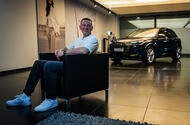How does Audi’s design philosophy shape the interiors of its latest electric models?
Ramon Bäurle, the creative force behind the interiors of the Audi A6 e-tron and Q6 e-tron, doesn’t just sketch dashboards—he reimagines what it means to sit inside an Audi. When asked about his approach, Bäurle describes starting with a blank sheet, competing with other designers, and pushing boundaries to ensure Audi’s interiors aren’t just good—they’re ahead of the curve. That drive for progress is at the heart of Vorsprung durch Technik, Audi’s iconic slogan, which Bäurle interprets as a relentless pursuit of being not just a leader, but truly ahead—sometimes in ways you can’t even plan for.
What does Vorsprung durch Technik mean for interior design?
For Bäurle, Vorsprung durch Technik is more than a catchy phrase—it’s a mindset. Vorsprung, meaning “being ahead,” is about setting ambitious goals and striving to surpass them, even when the path isn’t clear. The “through technology” part? That’s where Audi’s design team gets creative. They’ve shifted from traditional clay models to digital workflows, even using virtual reality to evaluate early concepts. The result? Interiors that aren’t just visually striking, but also deliver a seamless, intuitive experience for drivers and passengers alike.
Where do Audi’s designers find their inspiration?
You might think car designers only look to other cars for ideas, but Bäurle’s creative radar is always on. He draws inspiration from fashion, architecture, and even everyday objects. A well-designed chair, a beautifully crafted watch, or the way light plays on a building’s surface—these all spark questions that drive his process. Why is this product so compelling? How was it made? Could something similar elevate an Audi interior? That curiosity is what keeps Audi’s cabins feeling fresh and innovative.
What are the secrets to a truly great car interior?
According to Bäurle, it’s all about balance. Technical clarity is key—features should be integrated so they help, not distract. Both driver and passenger matter equally; the space should feel welcoming and functional for everyone. Materials play a huge role, too. High-quality surfaces at every touchpoint don’t just look good—they make the car feel more valuable and comfortable. And the design must fit the car’s purpose, whether it’s a sporty coupe or a long-distance cruiser.
Which Audi interiors have set the standard over the years?
Ask Bäurle to name milestone Audi interiors, and he lights up. The latest Audi TT, with its digital air vents and crisp details, stands out for its blend of technology and design. The classic Audi 100 introduced a wrap-around dashboard—an idea that still echoes in today’s models. And the R8? Its driver-focused, monoposto layout delivers pure race-car vibes, making the steering wheel the undeniable star of the show.
How did the vision for the Q6 e-tron and A6 e-tron interiors come together?
Before the first sketch, Bäurle and his team set out to create a cabin that felt clean, cohesive, and utterly modern. The goal was a 360-degree wrap-around architecture, where the dashboard and doors flow together seamlessly. Digital elements are woven in so naturally that they enhance the experience without overwhelming it. The result is a space that feels both futuristic and inviting.
What makes the new e-tron interiors stand out from the crowd?
Audi’s latest interiors are built on what Bäurle calls “aesthetic intelligence,” a philosophy anchored by four pillars:
Human centricity: Everything revolves around how people feel inside the car. The soft-wrap design makes the cabin feel like it’s embracing you, blurring the lines between dashboard and doors.
The digital stage: Technology isn’t just added on—it’s integrated. Ambient lighting delivers notifications, a curved panoramic touchscreen offers clarity and ease of use, and for the first time, passengers get their own interactive display. The augmented reality head-up display takes safety and convenience to a new level.
Visual clarity: Every element is designed to fit together as a single, harmonious sculpture. The seamless flow of surfaces and controls helps reduce cognitive load and makes the space feel calm.
Material-driven design: It’s not just about using premium materials, but about showcasing them with thoughtful shapes and lighting. Shadows and highlights are used to bring out the best in every surface.
Audi also listens to feedback. When customers found the virtual wing mirrors on the Q8 e-tron awkwardly placed, the team moved them higher in the A6 e-tron for a more natural feel. And features like the panoramic sunroof with switchable transparency let drivers control the cabin’s mood with a touch.
How does Audi’s design philosophy shape the future of its interiors?
Bäurle believes that Vorsprung durch Technik is a living philosophy—one that pushes Audi to keep questioning and refining every detail. For interior design, that means never settling for “good enough.” The team is always searching for new ways to meet (and exceed) customer expectations, whether through smarter tech, better materials, or more intuitive layouts.
The big takeaway? Great interior design isn’t about perfection—it’s about smarter adjustments. Start with one change this week, and you’ll likely spot the difference by month’s end.

